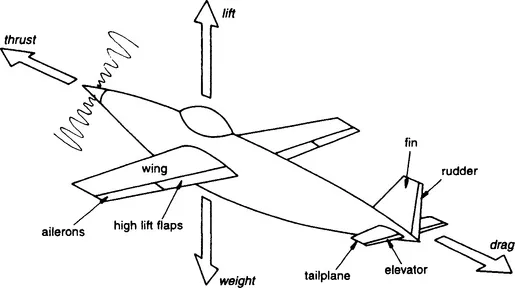1.1 The travelling species
From the time of our emergence as a separate species Homo sapiens has been a traveller, firstly on foot, then using animals and finally developing vehicles. Originally the journey was a daily search simply for food; later it was for new pastures for his animals or better land to grow crops on. This has led to the spread of the species to almost every part of the globe and to the present situation where journeys are made for every imaginable purpose. In spite of the development of telecommunications it appears that every year more people travel greater and greater distances, mostly by air. The vehicles have developed from sledges and carts to aircraft and spacecraft. Two broad characteristics of the vehicles have concerned us from the beginning: how far and how fast they can go and their control and stability. The load a horse can be expected to pull in a cart and how far in a day was of interest; there must be a means to stop, start and steer, and even a cart can overturn if overloaded and a corner is taken too fast.
This book then is concerned with one of mankind’s most productive forms of transport and its performance, stability and control characteristics. The later sections of this chapter are intended to be an introduction to the characteristics of aircraft that determine the performance, to engine performance and to the relevant properties of the atmosphere. Chapters 2 and 3 deal with aircraft performance, defined not only as how far and how fast it can fly, but also such things as the ability to climb, turn, take off and land. The performance of the aircraft is, of course, the reason for its existence and the most important starting point for design. The rest of the book is concerned with the stability and control of aircraft to which Chapter 4 forms an introduction.
The safety of the occupants and of the aircraft is one basic driving force in what we choose to study. The design and operation of aircraft is highly circumscribed by government safety regulations and we shall make occasional references to various airworthiness requirements but in no way will they be covered in detail.
1.2 General assumptions
The feature which characterizes all the topics dealt with in this book is that we are dealing with the interaction between the dynamics of the aircraft and the aerodynamic forces and moments generated on its surfaces by the motion. Other factors such as gravity have also to be included. However, the real situation is far more complex than we can reasonably hope to analyze completely. The atmosphere is a variable mixture of gases and vapours; it is never completely at rest and its properties such as density, pressure and temperature vary with position and time. The acceleration due to gravity varies slightly with latitude and height. The aircraft is an elastic body, distorting with every load on it, and losing mass as it burns fuel and uses other consumables. We therefore have to make a number of general assumptions.
• The aircraft is flying in a stationary atmosphere having constant properties.
• The aircraft does not deflect due to the loads placed on it.
• The aircraft is of constant mass.
• The acceleration due to gravity is constant.
• Accelerations of the aircraft due to motion about a curved rotating Earth are negligible.
These assumptions will apply throughout unless it is specifically stated otherwise. Probably the least justifiable assumption is the second which can have serious consequences if its effects are totally ignored.
For the purposes of determining aerodynamic forces and moments it does not matter if we consider the aircraft or some component of it to be flying at velocity V (a vector) through stationary air, or the aircraft or component to be stationary in a uniform, unbounded airstream of steady velocity -V at a large distance ahead. We shall use whichever point of view is the more convenient at the time.
Throughout this book we will keep strictly to the use of consistent units (e.g. SI) for simplicity. The practising aeronautical engineer, however, uses the most convenient units (such as dN, hours and knots) correcting the equations with suitable numerical constants.
1.3 Basic properties of major aircraft components
Before we begin to discuss the performance, stability and control of aircraft we need to have some general information on the components of the aircraft, a basic idea of their function and how their characteristics depend on such parameters as Mach number and geometry.
1.3.1 Functions of major aircraft components and some definitions
We must first be clear on the main functions of each component of the aircraft. These are summarized in figure 1.1 which shows an aircraft in level flight.
Fig. 1.1 Main components of an aircraft and primary forces
The primary function of the wings is to provide lift, which is defined as the aerodynamic force at right angles to both the direction of motion and the wing...

